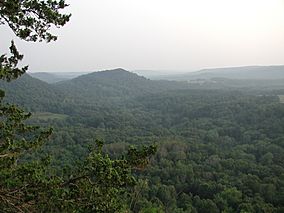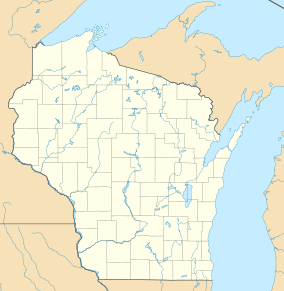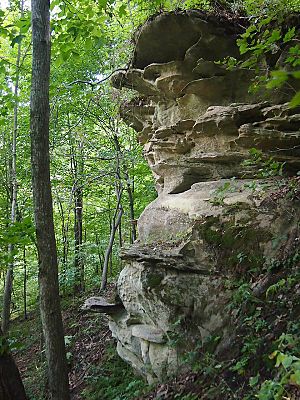Wildcat Mountain State Park facts for kids
Quick facts for kids Wildcat Mountain State Park |
|
|---|---|
|
IUCN Category III (Natural Monument)
|
|

A view of the Driftless Area from Wildcat Mountain State Park
|
|
| Location | Vernon, Wisconsin, United States |
| Area | 3,643 acres (14.74 km2) |
| Established | 1948 |
| Governing body | Wisconsin Department of Natural Resources |
| Website | Wildcat Mountain State Park |
Wildcat Mountain State Park is a fun place to visit in Wisconsin, United States. It sits along the Kickapoo River in a special area called the Driftless Area. This park has tall sandstone cliffs topped with limestone, like Wildcat Mountain and Mount Pisgah. From these spots, you can see amazing views of the narrow river valley.
The park is next to the Kickapoo Valley Reserve, making one big protected area. Wildcat Mountain State Park is open all year. You can enjoy hiking, canoeing, fishing, and cross-country skiing there. The park is 3,643-acre (1,474 ha) big and is located in Vernon County, close to the town of Ontario, Wisconsin.
Contents
Park History and Early People
Wildcat Mountain State Park is in the Kickapoo Valley. People have lived in this area for a very long time, even as far back as 2000 BCE. Scientists have found old Indian rock shelters and mounds in and around the park. These were likely temporary hunting camps. People living here did not farm the land. Historians think Native Americans used the Kickapoo Valley for hunting. They had more permanent homes near Tomah to the north and where the Kickapoo and Wisconsin Rivers meet to the south.
The Kickapoo River's Name
The Kickapoo River was known as the "river of canoes" by the Native Americans. Canoes brought the first European explorers to the area. French explorers from New France called the area "Bateaux." Later, British fur traders came after the French and Indian War. When English-speaking settlers arrived, they mispronounced "Bateaux" as Bad Axe. So, Vernon County was first called Bad Axe County. Its name changed to Vernon in 1862, which means greenness.
Early Settlers and Forests
When the first American pioneers arrived, the Meskwaki and Sac Indians lived in the Kickapoo Valley. Later, the Ho-Chunk people lived there. In 1837, the United States government made the Ho-Chunk move west of the Mississippi River.
The land was covered with huge old-growth forests. These trees were soon cut down by lumberjacks. The first American settlers were mostly from the New England states. They came to the area around Wildcat Mountain to cut lumber and farm. Later, Cornish miners also came to the region.
The Lumber Industry's Impact
The United States needed a lot of lumber as it grew. Forests in other parts of the country were cut down first. By 1844, the lumber industry reached Wisconsin.
John Ostrander and William Saubert bought many acres of land where Wildcat Mountain State Park is now. Their company bought the land for $1.25 an acre from the government. They clear-cut the forests, meaning they cut down all the trees. Then, they sold the cleared land to new settlers for $2.50 an acre. A small community of lumberjacks lived there as long as there were trees to cut. This community had a gristmill, post office, and school. By 1900, the community was empty.
Many people stayed and started small family farms. They used the natural resources of the Driftless Area. They built homes near streams for fresh water and fish.
The lumber industry hurt the environment. Cutting too many trees affected the water table, which is the level of water underground. Without trees and their roots, more water ran off the land instead of soaking in. This caused stream levels to drop, and many natural springs dried up. Because of this overuse of resources, some early settlers had to move away, and the lumber towns were left empty.
Ginseng Business
A big ginseng business used to be important in Vernon County. Ginseng is a plant root used by Chinese people for medicine. People in the area collected the wild ginseng and sold it in Woodstock, Illinois. For a while, Vernon County was the biggest producer of ginseng in the United States.
Park Creation
The idea to protect Wildcat Mountain started in 1938. A local man named Amos Saunders gave 20 acres (8.1 ha) of land for a park. The park grew to 60 acres (24 ha) in 1947 when the state of Wisconsin bought it. Wildcat Mountain State Park was officially created in 1948. Since then, it has grown to 3,643 acres (1,474 ha).
Park Geology and Landforms
Wildcat Mountain State Park is in the Driftless Area. This is a special part of Wisconsin, Minnesota, Iowa, and Illinois that was not covered by glaciers during the Last Ice Age. "Driftless" means there is no glacial drift, which is the material left behind by melting glaciers.
The hills in the Driftless Area are made of old Precambrian sandstone with limestone on top. The whole area is like an eroded plateau with rock underneath. The river valleys here are very deep. The cliffs along the Mississippi River basin are almost 600 feet (180 m) tall.
Park Ecology: Plants and Animals
Wildcat Mountain State Park has a woodland ecosystem. The Kickapoo River Valley and the park are home to many animals found in the woods of the Upper Midwest.
Birds and Other Wildlife
Common birds you might see include tundra swans, Canada geese, great blue herons, sandpipers, wild turkeys, red-tailed hawks, bald eagles, and turkey vultures. Reptiles also live in the park, like five-lined skinks, red-bellied snakes, and eastern hog-nosed snakes. Mammals like White-tailed deer, red squirrels, and beaver are also found here.
Unique Plant Life
Mount Pisgah in Wildcat Mountain State Park has been kept in its natural state. It is covered with old-growth white pine and hemlock trees. These trees were never cut down by loggers or eaten by farm animals. The park is also home to different kinds of ferns, including maidenhair, interrupted, and the unusual walking fern.
Recreation and Activities
Wildcat Mountain State Park is open for fun all year long.
Canoeing and Fishing
The Kickapoo River is famous for its many miles of slow-moving water that flows through wild areas. This makes it a great place for canoeing. When you canoe, you can see rare plants along the riverbanks and watch wildlife like muskrats, belted kingfishers, green herons, and great blue herons. Scientists have found up to 46 types of fish in the river. The Kickapoo is also a Class II trout stream, which means it's good for trout fishing. Brown trout spawn in the smaller streams that flow into the river within the park.
Trails and Other Fun
Wildcat Mountain State Park has over 20 miles (32 km) of trails. You can use these trails for hiking, snow shoeing, horseback riding, and cross-country skiing. The park also offers special programs to learn about nature, a nature center, picnic areas, and spots to watch birds and other wildlife.




